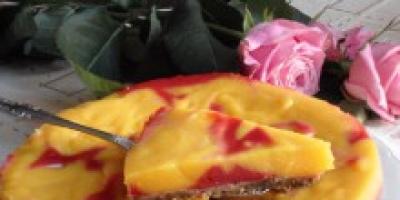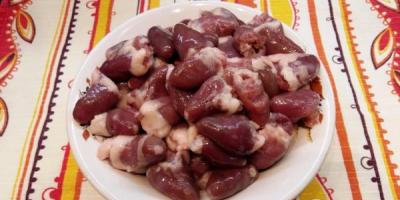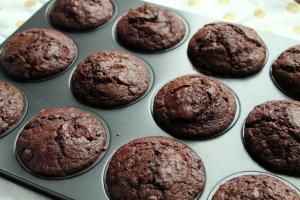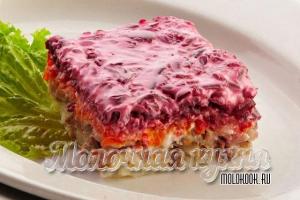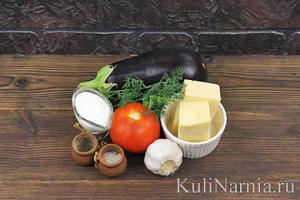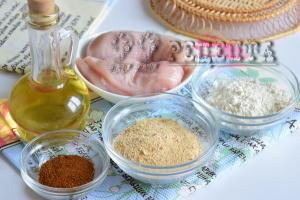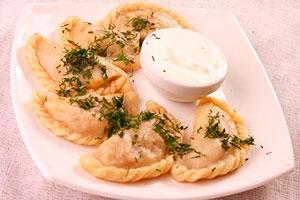The most delicate dessert from cottage cheese or sour cream, thick cream, homemade marshmallows and many others delicious products It is impossible to prepare if you do not know how to properly dilute gelatin. In order for jellied meat and jelly to obtain the required consistency, you need to add a thickener, observing the proportions of liquid and gelling powder. Once you figure out how to dissolve gelatin, there will be no more difficulties with preparing aspic.
Benefits and types of gelatin
Gelatin is not only a thickening agent, it is also a very useful protein supplement. The substance is an animal protein - collagen. The dry powder contains about 87% proteins.
Collagen is responsible for the beauty and elasticity of the skin, so for women it is especially necessary both in cosmetics and food products. It is useful to take collagen internally for those who have problems with cartilage tissue and joints.
Gelatin is sold in three types:
It is best to prepare dishes with gelatin at home with your own hands. Both tastier and healthier.
Proportions
To ensure the product has the correct consistency, it is best to strictly adhere to the recipe. If there are no instructions on the package or exact dosage in the recipe, you should adhere to the following proportions:
- For regular jelly or aspic you need to take 25-30 g gelatin powder per 1 liter of liquid.
30 g is 2 tablespoons with a small “hill”. If the jellied meat is fatty (from pork) and the jelly contains a lot of sugar, then it is better to slightly increase the dosage of the thickener. These proportions are suitable for jellied tongue, fish, chicken jellied meat or boneless meat. - If thick jelly is required, especially for decorating cakes and desserts, then the amount of thickener must be increased to 40-50 g per liter.
If you're interested, here's my recipe. I prepared it for New Year 2019, and all the guests liked the shape of the pig.
Collagen is obtained from cartilage, bones, tendons by boiling them. Therefore, when preparing jellied meat, you can do without gelatin at all, but then you need to cook it from meat with the addition of pork feet or chicken feet. You will have to simmer the raw meat over low heat for at least 3-4 hours, then the collagen will go into the broth.
How many grams of gelatin are in 1 spoon?
- 5 g of gelatin is 1 teaspoon of powder;
- 15 g – 1 tablespoon;
- 20 g – 1 tablespoon plus 1 teaspoon.
It is also worth paying attention to the manufacturer's recommendations on the bags. They are very different. For example, Dr. Oetker 6 sheets of gelatin weigh 10 g, they are designed for 500 ml of liquid. On instant gelatin labels, most manufacturers recommend using 10 g of powder per 1-1.5 cups (200-300 ml) of hot liquid.
If you use gelatin in sheets, you need the same quantity as powdered gelatin.
The “enemies” of gelatin are: fresh fruit: kiwi, pineapple, fig. They contain specific enzymes that destroy collagen. Before using these fruits for jelly, you need to boil them or take them in canned form.
Sequence (how to add)


If the bag says “instant,” then the powder does not need to be pre-soaked in cold water. It's the easiest to work with. While the jellied meat or fish aspic is being cooked, it is enough to take a small portion of the hot liquid and dilute the gelatin in it. Then pour in the gelling solution at the end of cooking.
How long does jellied meat with gelatin take to harden?
Gelatin begins to “work” (stabilize) at a temperature of +15 º C and below. That is, the entire contents of the dish must cool. The cooling time depends on what kind of broth the meat was poured into, hot or at room temperature. The pole needs to take into account the thickness of the layer. On average, jellied meat freezes in 5-6 hours.

The jellied meat does not freeze, what should I do?
This often happens when you prepare jellied chicken or aspic from tongue or fish. If the cold food has not frozen after 4 hours in the refrigerator, you can “reanimate” it.
- Melt the jellied meat and measure the volume.
- Calculate the required amount of thickener, soak it, and let it swell.
- Bring the broth to a boil (do not boil), add the gelling solution. Pour into molds and cool.
To be on the safe side, you can check the “strength” of the jellied meat by first placing a tablespoon of it in the refrigerator. After 20 minutes it should turn into a gel. The second way to check is to soak your fingers in warm (not hot!) broth. They should become sticky, sticking together a little when touched.
Agar - an alternative to gelatin
Vegetarians can replace gelatin with a plant-based thickener - agar, extracted from seaweed. It is also sold in supermarkets. If gelatin dissolves in hot water, then agar only dissolves in boiling water. He needs liquid with a temperature of 90-100 degrees.

To prepare jelly or aspic, pour boiling water over agar-agar powder and leave for 15 minutes to swell. Then add to the main volume of broth or syrup, bring to a boil and boil for 2-5 minutes. Since agar is a stronger thickener, its consumption is 5 g per 500 ml of liquid (10 g per 1 liter).
Jellied meat, fish jellied fish or multi-colored jelly - all these dishes prepared at home will be beneficial. The correct dosage of gelatin provides them with an attractive appearance and dense consistency.
Gelatin is sold in the form of coarse powder or sheets. In order for it to be used in dishes, both one and the other must be diluted. Gelatin can be diluted with any liquid (water, juice, broth) - it depends on what dish it will be added to later. It can be fruit jelly, sour cream soufflé, meat or fish aspic. You can even make a cake using gelatin. Now we will tell you how to dilute gelatin, and give some of the most simple recipes with its use.
Dilute gelatin powder as follows:- Pour as much gelatin into the ladle as indicated in the specific recipe. For reference: one standard tablespoon contains 15 g of gelatin (without top).
- Fill it with five tablespoons of warm water, juice or broth.
- Let the gelatin swell - this will take 10-15 minutes.
- Pour half a glass of the same liquid in which it swollen into the swollen gelatin.
- Place the ladle in a water bath and, constantly stirring the contents, ensure that the ladle forms a thick, viscous mass. Be careful not to allow the contents to boil.
- If after the water bath there are still undissolved grains of gelatin in the container, then strain the contents through a kitchen strainer.
- Fill the required number of plates with cold water.
- After 5-7 minutes, drain the water and squeeze the moisture out of the plates well.
- Place the swollen records in a ladle and fill with juice, broth or water.
- Place the ladle in a water bath and stir the mixture constantly. Make sure it doesn't boil.
- Pour the prepared gelatin mass into the main liquid.


- for a slightly gelled dish, as if “breathing” - 15 g;
- for normal jelly – 20 g;
- for very strong jelly – 25 g.
Strong jelly can be used to cut out decorations for any dishes.
Using gelatin, you can prepare delicious and original fruit and sour cream jelly:- Dissolve 10 g of gelatin in water.
- Whisk 500 ml sour cream and 1 cup sugar.
- Pour diluted gelatin into the whipped sour cream and mix well.
- Take four transparent glasses and pour 125 ml of sour cream into each.
- Place the glasses in the refrigerator for 2-3 hours.
- From 10 g of gelatin and 500 fruit juice, make the second part of the jelly.
- Place pieces of fresh fruit or berries on the frozen sour cream jelly.
- Fill them with the prepared fruit mixture.
- Place the glasses with two-layer jelly in the refrigerator again to harden.


- Bake a sponge cake or buy a store-bought one - only 500 g.
- Cut the biscuit into cubes measuring 2 by 2 cm.
- Cut banana, kiwi, strawberries, tangerines into the same cubes. Take any fruit, but in total there should also be 500 g.
- Prepare a sour cream mixture from one liter of sour cream and 25 g of gelatin. Before adding diluted gelatin to sour cream, beat it with two cups of sugar.
- Take a deep bowl and cover it with cling film.
- Pour one cup of sour cream-gelatin mixture into the bottom of the bowl.
- Place pieces of biscuit and pieces of fruit mixed onto the sour cream.
- Fill this layer with sour cream.
- Next, add the biscuit and fruit again.
- Fill the bowl to the top, alternating sour cream and sponge-fruit layers.
- Place the bowl in the refrigerator overnight.
- Before serving, place the bowl of cake in hot water for a couple of seconds.
- Place a large flat plate on top of the bowl and turn everything over so that the cake is on the plate.
- Remove the film from the cake and cut it into portions.


If you have cooked jellied meat and it has not frozen, then heat it up and dilute the gelatin in this broth. Add it to the dish and put it in a cold place - the jellied meat will be saved.
Edible gelatin is a powder that is made from animal and fish tissues. It boasts of its composition, as it contains collagen.
Let's look at the basic tips that must be followed to achieve the desired result.
The powder must be dissolved in cold water and left for some time to swell. After the powder swells, place on low heat and melt.
Tip 1 . Strict maintaining proportions. This rule is very important; if the proportions are not observed, your dish will have a rubbery consistency or will not harden at all.
- to achieve an “airy, quivering” dish, you must maintain a proportion of 20 grams per 1 liter of water,
- to achieve “thick jelly”, use 40-60 grams of gelatin per 1 liter of water.
Tip 2. It is worth remembering that gelatin must not be boiled. If you overheat it and boil it, it simply won’t thicken.
Tip 3 . Not worth it cool dissolved gelatin at low temperatures, for example in the freezer. As a result, you will get gelatin in crystals.
Tip 4. It is important to use a product with good expiration date, don't forget to check it when purchasing.
Consider a recipe for making gelatin for a sweet dessert.
Dilute the powder in cold water, maintaining a ratio of 1:5 and leave to swell for half an hour. After the time has passed, place the swollen powder in a water bath until completely dissolved, remembering to stir constantly. When preparing dessert, you can use a trick to dissolve gelatin in juice or coffee. This will give a special taste to your dish. To ensure that there are no lumps in the dessert, you need to place the melted gelatin in the dish while it is warm.
We dilute gelatin for aspic or jellied meat.
To prepare gelatin for jellied meat (aspic), you must maintain a ratio of 1:5. We use cold boiled water. To dilute the powder, leave it for 10 minutes, then place the resulting mixture in the hot broth. This recipe is suitable for instant gelatin.
To dilute regular gelatin, you need to dilute the powder in the proportion indicated on the package. After diluting the powder in water, leave it for 30 minutes for the best divergence. Melt the gelatin in a water bath, then place it in the broth and bring to a boil.
How to dilute gelatin: tips for preparing desserts, jellied meats and jellied meats
👍, Dishes prepared with gelatin always amaze with their beauty and unusual taste.
How to make jelly from gelatin
For those with a sweet tooth who love to indulge light desserts, you will like homemade jelly, which can be made using gelatin. The component is tasteless and odorless, therefore ready dish will have the aroma of the berries or fruits from which it is made. The dessert turns out very tasty, beautiful and healthy.
How to make jelly
Sweetness in the form of jelly is very popular all over the world because it is not only tasty, but also useful product. It can be prepared using gelatin, pectin or agar-agar. These components help achieve the required consistency. To make the dessert delicious, you need to follow some rules on how to prepare jelly:
- Do not use aluminum containers to make sweets. In such dishes, the mass may darken and develop a specific taste.
- Adding a small amount of wine or lemon juice will help improve the taste of the dish.
- You can prevent the formation of gelatin lumps by pouring it into a container with a warm bottom. The best option It is considered to place the container in a water bath.
- The product must harden inside the refrigerator. The substance needs to be made into an elastic, dense mass, and not frozen, so do not put it in the freezer.
Many housewives buy ready-made powders because they are easy to prepare. The difference lies in the benefits of the product. At home, you can come up with many options: the jelly base is prepared from syrups, milk, sour cream, cream, alcoholic drinks, juices, compote, lemonade and other sodas (the child will love the Cola dessert). As a filler, add various fruits (apples, pears, oranges, pineapples, lemons), berries (gooseberries, cherries, red currants, grapes, strawberries), pieces of cottage cheese soufflé.
The product can be used as an independent dish. It is recommended to use sweets prepared for the winter for diluting fruit drinks and preparing jelly. If you haven't canned the compote, stir a small amount of jelly with water. The product is used for decoration and filling confectionery: cakes and pastries. Jelly brings lightness and is a bright decoration element.
How to dilute gelatin
An important part of the process of how to make jelly from gelatin is the dilution of the thickener. The correct proportions will help you create a delicious dessert:
- It is important to maintain the correct proportions. Gelatin powder should be diluted at the rate of 5 g per 50 ml of water.
- The crystalline substance must be poured with boiled water, which must first be cooled. Gelatin will swell from half an hour to 40 minutes.
- Heat the resulting substance using a water bath. The process should be carried out until the powder is completely dissolved.
- The finished gelling component should be mixed with the base for the dessert (compote, juice, milk).
How to make jelly from gelatin
Every housewife should know how to make jelly from gelatin. Delicious dessert Can be eaten alone or used to garnish other dishes. Learn cooking rules and recipes
Every housewife at least once in her life pleased her household with such delicious dishes, like aspic or jellied meat, which cannot be prepared without gelatin. In addition, if it weren’t for this product, we wouldn’t be enjoying marmalade and jelly. But not everyone knows what they are made from. And also, not everyone knows that these are vitamins and minerals that are so beneficial for the human body.
Methods for obtaining gelatin
This product is obtained in several ways. First, food - these are bones. This product is processed, and the output is a tasteless and odorless substance.
Some manufacturers add blood, tendons, hooves and other components to the bones. This allows them to obtain a larger quantity of finished products.
But gelatin is not only made from bones. How to prepare it in another way is well known to those who purchase large quantities of brown and red algae. They grow in the Pacific Ocean, in the White and Black Seas. Of course, the product obtained from algae has a different name - agar-agar. However, in terms of its properties, it is in no way inferior to the product obtained by processing cattle bones.
Is it possible to make gelatin yourself?

You can, of course, prepare it at home, but this process is very long and tedious.
First you need to purchase a large number of bones, pork legs, ears, etc. The whole thing is soaked for eight hours. In a shorter period of time, all the blood simply will not have time to come out of the food. After this, the skin (where it is) is carefully scraped off and all the ingredients are washed. All this is boiled in water for several hours.
However, in this way you can only prepare jellied meat or aspic. For making other dishes (jelly, marmalade, etc.), it is better to use ready-made gelatin.
Product composition

As you already know, this product contains a lot of minerals, vitamins and proteins. Scientists carried out chemical analyzes that allowed them to accurately answer the question of what food gelatin consists of.
It contains glycine. This is a very useful and necessary amino acid for humans. A sufficient amount of glycine in the body helps to increase the level of vital energy, the development of mental activity and normal functioning in general.
This product also contains (in small quantities) some trace elements. These are calcium, sulfur and phosphorus.
Proteins, fats and carbohydrates
We already know what food gelatin consists of. Let's look at it in percentage terms:
- fats - 0.4%;
- carbohydrates - 0.7%;
- proteins - 87.2%.
A large number of proteins directly indicates that what food gelatin is made from is of animal or plant origin.
In addition, this product contains protein amino acids - hydroxyproline and proline. In the human body, their presence ensures the strength and health of connective tissues.
Diluting gelatin: how to prepare it correctly

For ideal dissolution of the product, it is best to take cold water. If you add gelatin directly to juice, milk or broth, then its granules will not completely dissolve, no matter what you do, no matter how thoroughly you mix it later.
Pour one tablespoon of gelatin into the bottom of a small bowl (preferably a metal one). After this, the substance is poured with half a glass of boiled, chilled water. When using regular gelatin, leave a bowl of water for fifty minutes to allow it to swell. The instant one swells in just twenty-five minutes.
After this, the bowl of gelatin is placed over a pan containing boiling water ( water bath). We keep the dishes on low heat for about ten minutes, periodically stirring the swollen mass until it is completely dissolved in water. As soon as the liquid becomes completely transparent, the bowl can be removed from the heat.
There is one rule that you need to remember if you want to learn how to make gelatin without spoiling it. The product must not be brought to a boil. When the temperature reaches 100 0 C, collagen (protein) is completely destroyed. As a result, gelatin will completely lose its main property - gelation. And this process is irreversible, so you can pour out the boiled liquid without regrets and start the whole process all over again.
The product dissolved in water must be cooled. The optimal temperature is 50 0 C. Before adding the resulting solution to the dish, it must be passed through a sieve. This will get rid of the film that forms on its surface when heated.
By the way, gelatin does not tolerate not only boiling, but also too low a temperature. The product cannot be stored in freezers. When frozen, it crystallizes and subsequently stratifies. After thawing, its gelling property also disappears. Such a product can be safely thrown into the trash, following the boiled solution.
Where is gelatin used?

We learned what food gelatin is made from, and what is prepared from it? In what areas of our lives is this product used?
Of course, it is most often used in cooking. In which dishes is food gelatin not added? The price of this product is low, but its properties are irreplaceable. It is used to prepare mousses, jellies, jellied meats, various aspics, and so on. Gelatin is also used in confectionery factories. To enhance the taste it is added to sweets. This product, added to ice cream, prevents sugar from crystallizing and proteins from coagulating. Manufacturers of canned meat and fish also resort to its help.

Gelatin will also be a real godsend for those who dream of impeccably beautiful hair. Vitamin E, which is found in this product, accelerates hair growth and strengthens it. In addition, it contains substances that strengthen the hair structure. Based on it, special masks are made that give volume, shine and elasticity to the hair.
Gelatin is used to make cosmetics, photographic materials, perfumes, printing ink and glue.
This product is also used in pharmaceuticals. Capsules for medicines are made from it. Gelatin capsules retain all the properties of the drug well, and when they enter the human body they dissolve easily and quickly.
Jellied meat that doesn't harden or jelly that doesn't want to hold its shape - that's a problem, that's a problem! The slightest mistake in choosing the method and temperature when working with gelatin and the products are almost hopelessly spoiled. Let's learn how to dissolve gelatin correctly, and for any purpose.
How to melt gelatin correctly
The description of the process, as a rule, fits into a couple of lines: pour, heat, stir - done! How many times, because of this brevity, have housewives had to blush, and guests have had to sigh as they look at plates of unappetizing mash. Meanwhile, there are absolutely no difficulties in how to dilute gelatin for a cake, or any other dish, you just have to scrupulously follow the technology and once again read the instructions on the package.
It is clear that the exact proportions for all dishes to which gelatin is added cannot be applied to a small pack. Today we will also describe only typical proportions and only in relation to high-quality product granules. Knowing how to properly dilute gelatin for jelly, you can do this in other cases, and a sense of proportion and following the recommendations will help you avoid making mistakes.
Before melting the gelatin, soak it in boiled water for a while. The temperature of the liquid should be no higher than the air in the kitchen, but it can be a little cooler. Proportions start from 20 grams of granulated gelatin per liter of liquid and reach 60 grams.
The given ratios apply to cases where gelatin is the only gelling agent and are suitable, for example, for sweet jellies. Of course, if the task is how to properly dilute gelatin for jellied meat, the proportions will have to be recalculated somewhat. The duration of soaking is until the granules noticeably dissolve, most often this happens no longer than half an hour.
- If your jellied meat is cooked on a meat-and-bone basis, it contains cartilage, joints, and skin. The amount of gelatin in this case will be about a tablespoon per liter of broth.
- If the question is: how to properly dilute gelatin for chicken jellied meat, you will have to increase the concentration. So, if the broth was cooked exclusively from pulp, then the minimum amount of gelatin is 55 grams per liter. If there are seeds and giblets in the jellied meat, 30 grams is enough.
- Sometimes chicken feet are added to the broth. This best way you can do without adding gelatin at all, but to be on the safe side, you can add the same amount of thickener as in the first point.
PLEASE NOTE!
Gelatin in jelly or aspic is usually soaked in ready-made broth. The proportion does not change, and the same rule applies to liquid as to water: the temperature should not be higher than room temperature.
Having told you how to properly dilute gelatin for chicken or other meat aspic, we cannot ignore desserts made from jelly. In all cases, we take the ratio from the formula already given: 4:100... 6:100 grams, with a small reservation. Jelly is usually not made very sweet. If you have a significant amount of sugar, add another 1/2 to the mass of gelatin used.

How to melt gelatin in a water bath
Proportions, soaking, all this is important, but relatively simple. Most often, errors lie in wait at the last stage - heating. It’s not difficult to avoid them, just take your time. Build a simple structure by taking two bowls or saucepans of different sizes. The smaller one should fit freely inside the larger one, without touching its bottom.
Pour water into a large saucepan, preferably warm, and place the already soaked gelatin into a smaller container. We install the structure on the stove, turn on moderate heat under it. As the gelatin warms up, stir the mass, waiting for maximum dissolution of the granules. Do not allow the mixture to boil; if the gelatin is overheated, immediately remove the inner container and cool slightly.
After you notice within a couple of minutes that it is not possible to achieve greater homogeneity of the mass, remove the gelatin from the water bath and rub it while still warm through a sieve. The method is suitable for any recipe, for example, if the task is how to dilute gelatin for cream in a cake.
If you have a thermometer among your kitchen appliances for measuring the temperature of food, be sure to use it. Monitor the readings and do not allow the mass to heat above 75 degrees. If possible, try to keep the mark even lower. If the granules confidently disperse at 60 degrees, do not increase the heat.
